ABSTRACT
Precision agriculture for rice cultivation has been applied in the targeted areas. By using technology or innovations that were invented by the government, the private sector or farmers have developed for rice cultivation. The use of PA in the cultivation of rice farmers depends on three factors: farmers do not know the technology or innovation; farmers do not accept technology, and it is an expensive technology. However, all sectors have to help in the implementation of the PA in the area. There are 7 categories of using precision agriculture in rice cultivation, variety/timing of planting, land preparation, planting, fertilizer application, spraying/ board casting methods, water management, harvesting and farm accounting. The implementation of precision agriculture for rice production cannot use 1 or 2 technologies or innovations. Some technologies are suitable for one area, but they may not be able to apply to other areas. The transfer of technology that is useful, practical, and suitable must be concerned. In each area, there should be appropriate technology packages, such as rice planting methods and tailor-made fertilizer application technology. The goal of precision agriculture was to create site-specific management (SSM) by cost saving and high efficiency. Moreover, the farmers should have the decision support system (DSS) for their decision of new planting.
Keywords: Application, Economic, Precision agriculture, Rice, Sustainability
INTRODUCTION
Rice, most consumed cereal of Asia, feeds most of the world’s population. More than 90% of the world’s rice is grown and consumed in Asia, where 60% of the earth’s people (Khush and Virk, 2000). The green revolution helped to solve the world’s demand for food, but it is not enough to meet the 21st century’s increasing population. However, the rice planted area in major producing countries has been decreasing because of the conversion of land for housing, industries, and highways. Hence, the future rice demand will be met with less land, low soil fertility, less water, less labor, pest and diseases, and fewer chemicals. To meet this challenge, it needs to develop rice varieties and cultivation with higher yield potential, greater yield stability, and higher micronutrient contain (Khush, 2008; Khush, 2013).
Thailand is a Southeast Asia country, with a population of about 68 million people. The country's GDP is about 1,054 Billion, with average 15,319 per capita (2017). Most of the country's GDP comes from industrial and service sectors, 45 and 43 % respectively. The agricultural sector shares a GDP only 12 %. The total area of Thailand is 51.3 million hectares. Most areas of the country are used for agriculture, with 47.4 percent and half of the agricultural area, 49 percent are being areas for rice cultivation (Figure 1) (Office of Agricultural Economics).
Rice is central to Thai society. Rice production uses half of the arable land and force in Thailand. Owing to rice is one of the main foods and sources of nutrition for most Thai people. The average consumption is 115 kg per capita a year. In Thailand, rice is also a major export crop. Despite its importance to the nation, the industry is under threat. The top three threats are, 1) increase in competition in the international market, 2) growing competition with other economic activities that increases the cost of production, especially the labor cost, and 3) degradation of ecological conditions. Rice research has to address these challenges (Wikipedia-Rice production in Thailand).
 a)
a)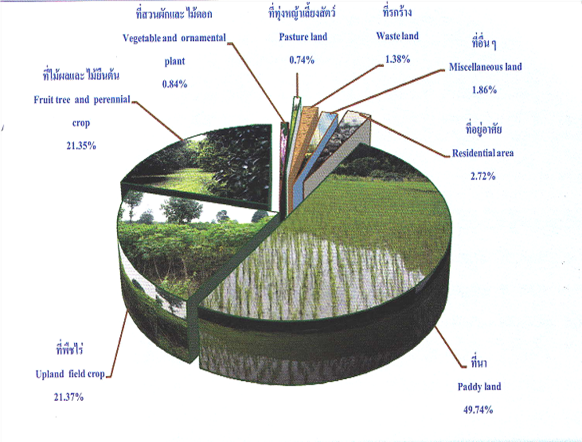 b)
b)
Figure 1. Land used in Thailand a) the whole country and b) in agriculture part
SMART PLATFORM FOR AGRICULTURE
Precision agriculture (PA) or precision farming is a modern farming management concept using digital techniques to monitor and optimize agricultural production processes. Rather than applying the same amount of management or agricultural chemicals over an entire agricultural field, PA will measure variations in conditions within a field and adapt its management strategies accordingly. PA methods promise to increase the quantity and quality of agricultural output while using less input (such as water, energy, fertilizers, and pesticides). The potential of precision agriculture for economic and environmental benefits could be visualized through reduced use of water, fertilizers, herbicides, and pesticides besides the farm equipment (Banu, 2015).
SMART platform is a big data management system for planning and organizing agriculture both individually and in the whole system. All the information was analyzed to report, predict, forecast, or to model the changing in the field by Agri Big Data system. Implementing practices were specified to the area by GPS guidance with the variable rate of technologies. This platform has developed as a data bank system for storing data from all 3 parts such as orthophoto taken from satellites or drones, meteorological data from the weather station and farmers' practices with smartphone applications. The data were analyzed and used for managing the field (Figure 2). This platform was used in rice as a model for implementation in the Rungsit plain. It consists of 5 provinces, namely Pathum Thani, Phranakhon Si Ayutthaya, Saraburi, Nakhon Nayok and Chachoengsao with covering an area of 1.9 million rai, most of which are agricultural lands, accounting for 69.39% (208,000 ha) of the total area. The rice area is 74.31% (157,000 ha), and the oil palm plantation area is 1,700 ha. (Figure 3)
.png)
Figure 2. The schematic diagram of data flow in SMART platform
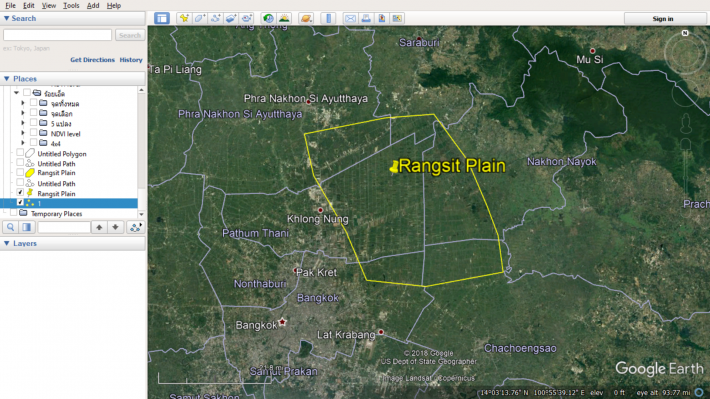
Figure 3. Location of the Rangsit plain
PRECISION AGRICULTURE FOR RICE PRODUCTION
Precision agriculture for rice cultivation has been applied in the targeted areas. By using technology or innovations invented by the government, the private sector or farmers have developed for rice cultivation. The use of PA in the cultivation of rice farmers depends on three factors: farmers do not know the technology or innovation; farmers do not accept technology, and it is an expensive technology. However, all sectors have to help to implement the PA in the area. There are 7 categories of using precision agriculture in rice cultivation, variety/timing of planting, land preparation, planting, fertilizer application, spraying/ board casting methods, water management, harvesting and farm accounting.
- Variety/timing of planting
Rice planning calendar, also "ปฏิทินล้นเกวียน", is invented by Mr. Nitat Charoenthamruk. It is a plan for rice planting to be successful. For planting rice, it will not allow the rice to flower during the hot weather (March-April) or cold weather (Dec-Jan), which will cause the pollination of rice to decrease and courses a yield loss. On the other hand of rice planting, it also has the problem of harvesting time at the monsoon season (August - September) with heavy rain, causing the lodging of the rice plant and yield loss. Moreover, during the monsoon season, the rice combined harvester faces the arduous condition of operation such as wet soil and high humidity. These reduce the efficiency of operation and make yield loss too. Sometimes, the rain can cause the delay in harvesting time, and it makes yield loss in both quantity and quality. To use the calendar, when the arrow is moved to the selecting rice varieties and planting dates, another arrow shows the harvest date. If the arrow falls in the green range, it means that the rice planting in this time might not face from all threats. If the arrow falls in the red range, indicating that rice cultivation has a risk and it should be avoided to plant in this time. (Figure 4)
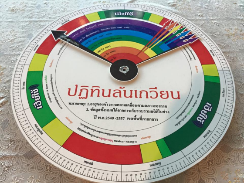
Figure 4. Rice planning calendar namely “ปฏิทินล้นเกวียน”
- Land preparation
Paddy field layout should be larger than before so that the machine can work more efficiently. When the small rice fields are combined into a large field, the farmers must make the plots to be the same leveling. However, making of the field to be the same leveling is often more costly than usual. Previously, the farmers would use the tools to adjust the field to be the same leveling by looking at the water level that was flooding in the field during land preparation. Current technology can use the GPS Laser Land Leveling machine to help the adjustment of the floor to be more efficient (Figure 5).
 (a)
(a) (b)
(b)
Figure 5. Land leveling machine a) the traditional methods and b) laser land leveling
- Planting
Most farmers in Thailand prefer to grow rice by a pre-germinated broadcasting method and use high seed rate, 156.25 – 187.5 kg/ha. Besides being a high seed cost to them with a high dense plant, it is also making suitable for the outbreak of diseases and insects. Encouraging farmers to use rice seeds at a lower rate and change the sowing method to planting in rows using planting machines will allow the farmers to save seed costs and improve the health of rice plants in paddy field. The rice drilling machine can use seed rate as 46.875 – 78.125 kg/ha. Moreover, rice seedling dropping machine use seed rate as 6.25 – 25 kg/ha (Figure 6). The rice drilling machine can be used to reduce seed cost by up to 50 %.
 a)
a) 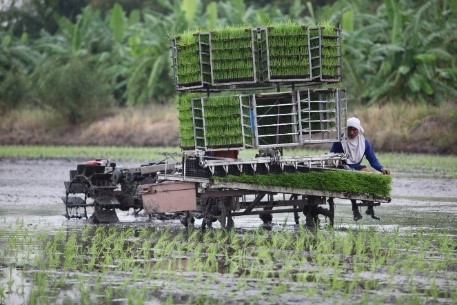 b)
b)
Figure 6. The modified machine for rice planting a) rice drilling machine and b) rice seedling dropping machine
- Fertilizer application
Soil testing analysis is a useful tool for making recommendations for the application of fertilizers to the crops. Kasetsart University developed Tailor-Made Fertilizer Application technology. There are 3 steps to use this technology such as 1) identification of the soil type of growing area by using soil map 2) collecting and analysis of the soil sample to measure the availability of nutrients to the crops and 3) preparation of fertilizer formulation based on their information by comparing with the guidelines (Figure 7). This technology can reduce the cost of fertilizer by 50 %.

Figure 7. The 3 steps of Tailor-Made Fertilizer Application technology.
- spraying/ board casting methods
Spraying or sowing chemicals by machines or drones have many advantages as follows; (Figure 8).
1) Security: protect farmers away from pesticide harm, to prevent poisoning and heatstroke incidents;
2) High efficiency: can spray or sow more than traditional methods;
3) Environmental protection: can spray pesticides with a fixed position and fixed orientation while reducing the pollution to water and soil;
4) Pesticides saving: high degree of atomization, the chemical fog can be pressed to all levels of the crop, can save more than 30% of pesticides;
5) Water saving: can adopt ultra-low volume spraying technology, water consumption is only 10% of traditional spraying method;
6) Same cost: the cost is the same as traditional spraying or sowing method;
 a)
a)  b)
b)
Figure 8. The spraying chemical in paddy field a) modified spraying machine and b) spraying drone.
- Water management
Alternate Wetting and Drying (AWD) is a water-saving technology that farmers can apply it to reduce their irrigation water consumption in rice fields without decreasing its yield. In AWD, irrigation water is applied a few days after the disappearance of the ponded water. Hence, the field gets alternately flooded and non-flooded. The number of the days of non-flooded soil between irrigations can vary from 1 to more than 10 days depending on the number of factors such as soil type, weather, and crop growth stage (IRRI) (Figure 9).
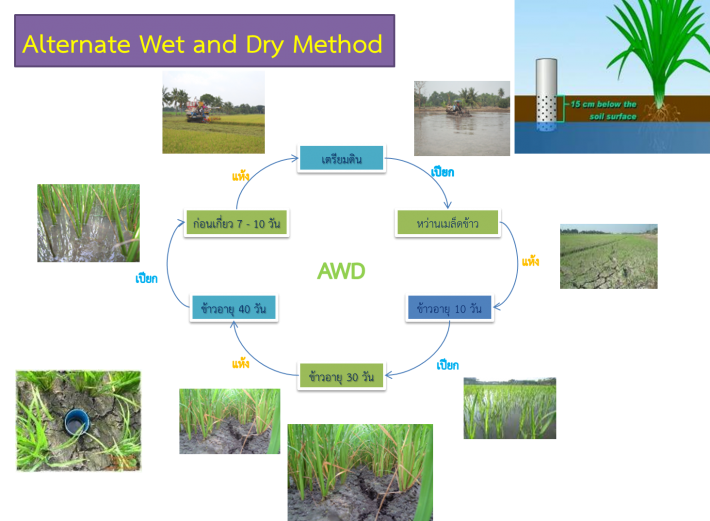
Figure 9. The Alternate Wetting and Drying (AWD) in pre-germinated broadcasting rice planting method.
- Farm accounting
The information on farm activities such as income and expenses that occur at each stage and concludes as an overview of each rice production are useful for planning of next cropping. Most of the farmers do not take notes but use methods of remembering. "Rice Time" smartphone application can be used to input these data through helping to increase the data storage efficiency (Figure 10). Farmers or other interested people can share the stored data via the QR code generated from the application. If this application is used to collect the data of farmers, then all data can be sent to the data canter to create a Big Data of the farm account. These data can be used to fulfill for further analysis.

Figure 10. The Rice Time application and QR code to download application
CONCLUSION
Implementation of precision agriculture for rice production cannot use 1 or 2 technologies or innovations. Some technologies are suitable for one area, but they may not be able to apply to other areas. The transfer of technology that is useful, practical, and suitable must be concerned. In each area, there should be appropriate technology packages, such as rice planting methods and tailor-made fertilizer application technology. The goal of precision agriculture was to create site-specific management (SSM) by cost saving and high efficiency. Moreover, farmers should have the decision support system (DSS) for their decision of new planting.
ACKNOWLEDGMENTS
The authors would like to thanks the team of the project of Development a System for Collecting Crop Cultural Practices Data to Create a Big Data for the Decision of Planting in Thung Rangsit, under the Agriculture Cluster, Research University Network (RUN), for conducting the research projects in Thung Rangsit. Authors also profoundly thanks for the research partners such as Ministry of Agriculture and Cooperatives (Rice department, Department of Agriculture, Department of Agriculture and Extension and Department of Land Development) for providing data and some analysis, as well as the necessary technical support. The research was made possible by funding of the National Research Council of Thailand.
REFERENCES
Banu, S. 2015. Precision Agriculture: Tomorrow’s Technology for Today’s Farmer. J Food Process Technol 6 (8): DOI: 10.4172/2157-7110.1000468
Khush, G.S. and P.S. Virk. 2000. Rice breeding: Achievement and future strategies. Crop Improvement. 27, 115-144.
Khush, G.S. 2013. Strategies for increasing the yield potential of cereals: case of rice as an example. Plant Breeding 132 (5): 433-436.
Office of Agricultural Economics: www.oae.go.th/
Rice Knowledge Bank: www.knowledgebank.irri.org/training/fact-sheets/water-management/ saving-water-alternate-wetting-drying-awd
Wikipedia-Rice production in Thailand: https://en.wikipedia.org/wiki/ Rice_production_in _Thailand
|
Date submitted: August 5~9, 2019
Reviewed, edited and uploaded: August 15, 2019
|


Precision Agriculture for Rice Production in Thailand
ABSTRACT
Precision agriculture for rice cultivation has been applied in the targeted areas. By using technology or innovations that were invented by the government, the private sector or farmers have developed for rice cultivation. The use of PA in the cultivation of rice farmers depends on three factors: farmers do not know the technology or innovation; farmers do not accept technology, and it is an expensive technology. However, all sectors have to help in the implementation of the PA in the area. There are 7 categories of using precision agriculture in rice cultivation, variety/timing of planting, land preparation, planting, fertilizer application, spraying/ board casting methods, water management, harvesting and farm accounting. The implementation of precision agriculture for rice production cannot use 1 or 2 technologies or innovations. Some technologies are suitable for one area, but they may not be able to apply to other areas. The transfer of technology that is useful, practical, and suitable must be concerned. In each area, there should be appropriate technology packages, such as rice planting methods and tailor-made fertilizer application technology. The goal of precision agriculture was to create site-specific management (SSM) by cost saving and high efficiency. Moreover, the farmers should have the decision support system (DSS) for their decision of new planting.
Keywords: Application, Economic, Precision agriculture, Rice, Sustainability
INTRODUCTION
Rice, most consumed cereal of Asia, feeds most of the world’s population. More than 90% of the world’s rice is grown and consumed in Asia, where 60% of the earth’s people (Khush and Virk, 2000). The green revolution helped to solve the world’s demand for food, but it is not enough to meet the 21st century’s increasing population. However, the rice planted area in major producing countries has been decreasing because of the conversion of land for housing, industries, and highways. Hence, the future rice demand will be met with less land, low soil fertility, less water, less labor, pest and diseases, and fewer chemicals. To meet this challenge, it needs to develop rice varieties and cultivation with higher yield potential, greater yield stability, and higher micronutrient contain (Khush, 2008; Khush, 2013).
Thailand is a Southeast Asia country, with a population of about 68 million people. The country's GDP is about 1,054 Billion, with average 15,319 per capita (2017). Most of the country's GDP comes from industrial and service sectors, 45 and 43 % respectively. The agricultural sector shares a GDP only 12 %. The total area of Thailand is 51.3 million hectares. Most areas of the country are used for agriculture, with 47.4 percent and half of the agricultural area, 49 percent are being areas for rice cultivation (Figure 1) (Office of Agricultural Economics).
Rice is central to Thai society. Rice production uses half of the arable land and force in Thailand. Owing to rice is one of the main foods and sources of nutrition for most Thai people. The average consumption is 115 kg per capita a year. In Thailand, rice is also a major export crop. Despite its importance to the nation, the industry is under threat. The top three threats are, 1) increase in competition in the international market, 2) growing competition with other economic activities that increases the cost of production, especially the labor cost, and 3) degradation of ecological conditions. Rice research has to address these challenges (Wikipedia-Rice production in Thailand).
Figure 1. Land used in Thailand a) the whole country and b) in agriculture part
SMART PLATFORM FOR AGRICULTURE
Precision agriculture (PA) or precision farming is a modern farming management concept using digital techniques to monitor and optimize agricultural production processes. Rather than applying the same amount of management or agricultural chemicals over an entire agricultural field, PA will measure variations in conditions within a field and adapt its management strategies accordingly. PA methods promise to increase the quantity and quality of agricultural output while using less input (such as water, energy, fertilizers, and pesticides). The potential of precision agriculture for economic and environmental benefits could be visualized through reduced use of water, fertilizers, herbicides, and pesticides besides the farm equipment (Banu, 2015).
SMART platform is a big data management system for planning and organizing agriculture both individually and in the whole system. All the information was analyzed to report, predict, forecast, or to model the changing in the field by Agri Big Data system. Implementing practices were specified to the area by GPS guidance with the variable rate of technologies. This platform has developed as a data bank system for storing data from all 3 parts such as orthophoto taken from satellites or drones, meteorological data from the weather station and farmers' practices with smartphone applications. The data were analyzed and used for managing the field (Figure 2). This platform was used in rice as a model for implementation in the Rungsit plain. It consists of 5 provinces, namely Pathum Thani, Phranakhon Si Ayutthaya, Saraburi, Nakhon Nayok and Chachoengsao with covering an area of 1.9 million rai, most of which are agricultural lands, accounting for 69.39% (208,000 ha) of the total area. The rice area is 74.31% (157,000 ha), and the oil palm plantation area is 1,700 ha. (Figure 3)
Figure 2. The schematic diagram of data flow in SMART platform
Figure 3. Location of the Rangsit plain
PRECISION AGRICULTURE FOR RICE PRODUCTION
Precision agriculture for rice cultivation has been applied in the targeted areas. By using technology or innovations invented by the government, the private sector or farmers have developed for rice cultivation. The use of PA in the cultivation of rice farmers depends on three factors: farmers do not know the technology or innovation; farmers do not accept technology, and it is an expensive technology. However, all sectors have to help to implement the PA in the area. There are 7 categories of using precision agriculture in rice cultivation, variety/timing of planting, land preparation, planting, fertilizer application, spraying/ board casting methods, water management, harvesting and farm accounting.
Rice planning calendar, also "ปฏิทินล้นเกวียน", is invented by Mr. Nitat Charoenthamruk. It is a plan for rice planting to be successful. For planting rice, it will not allow the rice to flower during the hot weather (March-April) or cold weather (Dec-Jan), which will cause the pollination of rice to decrease and courses a yield loss. On the other hand of rice planting, it also has the problem of harvesting time at the monsoon season (August - September) with heavy rain, causing the lodging of the rice plant and yield loss. Moreover, during the monsoon season, the rice combined harvester faces the arduous condition of operation such as wet soil and high humidity. These reduce the efficiency of operation and make yield loss too. Sometimes, the rain can cause the delay in harvesting time, and it makes yield loss in both quantity and quality. To use the calendar, when the arrow is moved to the selecting rice varieties and planting dates, another arrow shows the harvest date. If the arrow falls in the green range, it means that the rice planting in this time might not face from all threats. If the arrow falls in the red range, indicating that rice cultivation has a risk and it should be avoided to plant in this time. (Figure 4)
Figure 4. Rice planning calendar namely “ปฏิทินล้นเกวียน”
Paddy field layout should be larger than before so that the machine can work more efficiently. When the small rice fields are combined into a large field, the farmers must make the plots to be the same leveling. However, making of the field to be the same leveling is often more costly than usual. Previously, the farmers would use the tools to adjust the field to be the same leveling by looking at the water level that was flooding in the field during land preparation. Current technology can use the GPS Laser Land Leveling machine to help the adjustment of the floor to be more efficient (Figure 5).
Figure 5. Land leveling machine a) the traditional methods and b) laser land leveling
Most farmers in Thailand prefer to grow rice by a pre-germinated broadcasting method and use high seed rate, 156.25 – 187.5 kg/ha. Besides being a high seed cost to them with a high dense plant, it is also making suitable for the outbreak of diseases and insects. Encouraging farmers to use rice seeds at a lower rate and change the sowing method to planting in rows using planting machines will allow the farmers to save seed costs and improve the health of rice plants in paddy field. The rice drilling machine can use seed rate as 46.875 – 78.125 kg/ha. Moreover, rice seedling dropping machine use seed rate as 6.25 – 25 kg/ha (Figure 6). The rice drilling machine can be used to reduce seed cost by up to 50 %.
Figure 6. The modified machine for rice planting a) rice drilling machine and b) rice seedling dropping machine
Soil testing analysis is a useful tool for making recommendations for the application of fertilizers to the crops. Kasetsart University developed Tailor-Made Fertilizer Application technology. There are 3 steps to use this technology such as 1) identification of the soil type of growing area by using soil map 2) collecting and analysis of the soil sample to measure the availability of nutrients to the crops and 3) preparation of fertilizer formulation based on their information by comparing with the guidelines (Figure 7). This technology can reduce the cost of fertilizer by 50 %.
Figure 7. The 3 steps of Tailor-Made Fertilizer Application technology.
Spraying or sowing chemicals by machines or drones have many advantages as follows; (Figure 8).
1) Security: protect farmers away from pesticide harm, to prevent poisoning and heatstroke incidents;
2) High efficiency: can spray or sow more than traditional methods;
3) Environmental protection: can spray pesticides with a fixed position and fixed orientation while reducing the pollution to water and soil;
4) Pesticides saving: high degree of atomization, the chemical fog can be pressed to all levels of the crop, can save more than 30% of pesticides;
5) Water saving: can adopt ultra-low volume spraying technology, water consumption is only 10% of traditional spraying method;
6) Same cost: the cost is the same as traditional spraying or sowing method;
Figure 8. The spraying chemical in paddy field a) modified spraying machine and b) spraying drone.
Alternate Wetting and Drying (AWD) is a water-saving technology that farmers can apply it to reduce their irrigation water consumption in rice fields without decreasing its yield. In AWD, irrigation water is applied a few days after the disappearance of the ponded water. Hence, the field gets alternately flooded and non-flooded. The number of the days of non-flooded soil between irrigations can vary from 1 to more than 10 days depending on the number of factors such as soil type, weather, and crop growth stage (IRRI) (Figure 9).
Figure 9. The Alternate Wetting and Drying (AWD) in pre-germinated broadcasting rice planting method.
The information on farm activities such as income and expenses that occur at each stage and concludes as an overview of each rice production are useful for planning of next cropping. Most of the farmers do not take notes but use methods of remembering. "Rice Time" smartphone application can be used to input these data through helping to increase the data storage efficiency (Figure 10). Farmers or other interested people can share the stored data via the QR code generated from the application. If this application is used to collect the data of farmers, then all data can be sent to the data canter to create a Big Data of the farm account. These data can be used to fulfill for further analysis.
Figure 10. The Rice Time application and QR code to download application
CONCLUSION
Implementation of precision agriculture for rice production cannot use 1 or 2 technologies or innovations. Some technologies are suitable for one area, but they may not be able to apply to other areas. The transfer of technology that is useful, practical, and suitable must be concerned. In each area, there should be appropriate technology packages, such as rice planting methods and tailor-made fertilizer application technology. The goal of precision agriculture was to create site-specific management (SSM) by cost saving and high efficiency. Moreover, farmers should have the decision support system (DSS) for their decision of new planting.
ACKNOWLEDGMENTS
The authors would like to thanks the team of the project of Development a System for Collecting Crop Cultural Practices Data to Create a Big Data for the Decision of Planting in Thung Rangsit, under the Agriculture Cluster, Research University Network (RUN), for conducting the research projects in Thung Rangsit. Authors also profoundly thanks for the research partners such as Ministry of Agriculture and Cooperatives (Rice department, Department of Agriculture, Department of Agriculture and Extension and Department of Land Development) for providing data and some analysis, as well as the necessary technical support. The research was made possible by funding of the National Research Council of Thailand.
REFERENCES
Banu, S. 2015. Precision Agriculture: Tomorrow’s Technology for Today’s Farmer. J Food Process Technol 6 (8): DOI: 10.4172/2157-7110.1000468
Khush, G.S. and P.S. Virk. 2000. Rice breeding: Achievement and future strategies. Crop Improvement. 27, 115-144.
Khush, G.S. 2013. Strategies for increasing the yield potential of cereals: case of rice as an example. Plant Breeding 132 (5): 433-436.
Office of Agricultural Economics: www.oae.go.th/
Rice Knowledge Bank: www.knowledgebank.irri.org/training/fact-sheets/water-management/ saving-water-alternate-wetting-drying-awd
Wikipedia-Rice production in Thailand: https://en.wikipedia.org/wiki/ Rice_production_in _Thailand
Date submitted: August 5~9, 2019
Reviewed, edited and uploaded: August 15, 2019